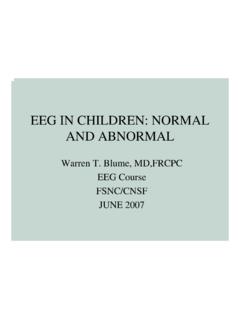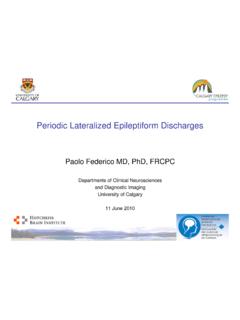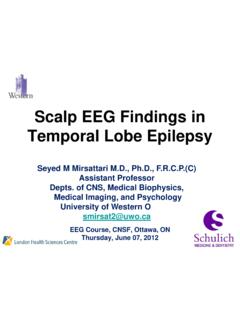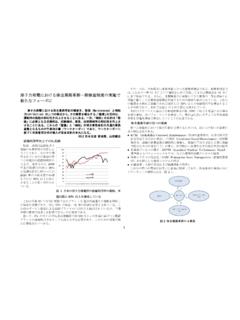Transcription of Seyed M Mirsattari, MD, PhD, FRCPC Departments of Clinical ...
1 Benign epileptiform variants Seyed M Mirsattari, MD, PhD, FRCPC . Departments of Clinical Neurological Sciences, Medical Biophysics, Diagnostic Imaging, Psychology University of Western Ontario London, Ontario EEG Course, CNSF, Quebec City, QE. Friday June 11, 2010. Learning Objectives To define Benign Epileptiform Variants (BEVs). To be able to classify BEVs into broad major categories To know the prevalence of BEVs Disclosure Statement ; Dr. Mirsattari has nothing to disclose. Definition of a Benign Epileptiform Variant in the EEG. EEG pattern that is morphologically epileptiform but is not associated with epilepsy. Significance of correctly identifying the BEVs in the EEG.
2 To avoid misdiagnosis of the subjects with epilepsy based on these waveforms To avoid unnecessary treatments of these subjects with anti-epileptic drugs or epilepsy surgery. To avoid other negative impact of epilepsy on the lives of these individuals, driving International 10-20 system of electrode placements Jasper ten-twenty electrode system of the International Federation. Electroenceph Clin Neurophysiol 1958;10:371- 5. EEG montages Bipolar Coronal Common Average Reference Referential Point =. CAR. EEG scalp recording: normal, awake Classification of BEVs Two major categories Sharply contoured BEVs: Wicket waves Benign sporadic sleep spikes (BSSS). BEVs occurring in bursts or trains: 6 Hz spike-waves 14 & 6 Hz positive spikes Rhythmic temporal theta bursts of drowsiness (RTTD).
3 Subclinical rhythmic electrographic discharge of adults (SREDA). To know the prevalence of BEVs Sharply contoured BEVs Wicket waves Benign sporadic sleep spikes (BSSS). Wicket waves Arciform, resembles Greek letter . Negative phase apiculate Positive phase rounded Single or clusters T3,4 or T3,4 & F7,8. No after-coming slow wave No distortion of background rhythms in drowsiness or sleep Unilateral or independent bilateral Wicket waves Santoshkumar et al. Clin Neurophysiol 2009;120:856-61. Sharply contoured BEVs Wicket waves Benign sporadic sleep spikes (BSSS). small sharp spikes (SSS). Benign Sporadic Sleep Spikes BETS Benign Epileptiform Transients of Sleep Abrupt ascending slope Steeper descending slope Usually short duration <50 msec Single after coming slow wave or dip in background Do not occur in trains Broad field seen best in long inter-electrode distances Often bilateral, with max amplitude on 1 hemisphere Cancellation A1,2, and posterior temporal T5-6.
4 Oblique dipole with opposite polarity both sides of head Do not disturb background Light NREM sleep; diminishes with deeper sleep Adults and adolescents Benign Sporadic Sleep Spikes BETS Benign Epileptiform Transients of Sleep Santoshkumar et al. Clin Neurophysiol 2009;120:856-61. BEVs occurring in bursts or trains 6 Hz spike-waves 14 & 6 Hz positive spikes Rhythmic temporal theta bursts of drowsiness (RTTD). Subclinical rhythmic electrographic discharge of adults (SREDA). 6 per second spike-waves (Phantom Spike and Wave). 5 7 Hz Brief low amplitude spike Slow wave has wider field than spike Adolescents and adults Awake, drowsiness, not sleep Bisynchronous <1 sec duration 6 Hz SW (cont.)
5 FOLD Female Occipitally-predominant Low- amplitude Drowsiness WHAM Wake High-amplitude Anterior Male FOLD appearance more benign WHAM appearance more suggestive of underlying generalized seizure disorder Benign 6 Hz SW should disappear in sleep, whereas pathological SW is often enhanced by sleep 6 Hz SW (cont.). Santoshkumar et al. Clin Neurophysiol 2009;120:856-61. 14 & 6 Hz positive spikes Positive component apiculate or arciform Negative component smooth 13-17 Hz or 6-7 Hz; principally 14 or 6Hz Drowsiness and light sleep Posterior temporal and adjacent areas Widespread field Best recorded: coronal or referential montages Adolescents, young adults 14 & 6 Hz positive spikes Santoshkumar et al.
6 Clin Neurophysiol 2009;120:856-61. Cortical Location of Benign Paroxysmal Rhythms in the Electrocorticogram o14&6 Hz positive spikes(4/61). 6 Hz SW(8/61). oBETS(3/61). McLachlan RS, Luba N. Can J Neurol Sci 2002;29:154-158. Rhythmic Temporal Theta of Drowsiness (Psychomotor Variant). 5-7 Hz Sharply contoured, often notched Mid-anterior temporal regions Parasagittal spread Bursts or runs Bilateral or independent either side or shifting emphasis side to side Can have a gradual onset and offset Monomorphic (no evolution). During relaxed wakefulness and drowsiness Mainly adolescent and adults Rhythmic Temporal Theta of Drowsiness (Psychomotor Variant). Santoshkumar et al.
7 Clin Neurophysiol 2009;120:856-61. Subclinical Rhythmic Electrographic Discharge of Adults (SREDA). Sequential monophasic or biphasic apiculate waves mixed with rhythmic theta or delta No evolution Abrupt onset and gradual offset Usually in wakefulness, occasionally in sleep May occur during HV. Principally parietal, posterior temporal Bisynchronous or unilateral Duration ~ 20 sec to a few minutes Occurs elderly or middle age SREDA. Santoshkumar et al. Clin Neurophysiol 2009;120:856-61. SREDA. First described by Westmoreland BF and Klass DW (1981). 65 patients (37 F; 28 M) between 1959 & 1978. Mean age 61 years (42-80 years). Non-evolving rhythm Widespread, maximal over the P-post T.
8 Duration: few seconds to a minute Westmoreland BF and Klass DW. Clin Neurophysiol 1981;51:186-91. Unusual variants of SREDA. Study interval= 1959-1995. N=108 patients (191 EEGs). 49 Males; 59 Females Mean age=62 years (range= 35-89 years). Prevalence=1/2500 recordings 89 with typical SREDA pattern Unusual variants (19/108). 10 Males; 9 Females mean age 61 (range= 35-89 years). Predominant frequencies Frontal or more focal distribution Notched waveforms Longer duration Atypical evolution Presence in younger individuals Occurrence in sleep Westmoreland BF and Klass DW. Electroenceph Clin Neurophysiol 1997;102:1-4. Decharges paroxystiques Naquet et al. 1961. Paroxysmal discharges of the parieto- temporo-occipital junction Reliably induced by: HV.
9 Pure relative hypoxia associated with nitrogen inhalation Mild relative ischemia from carotid artery compression Postulated that it was associated with cerebrovascular disease Naquet R et al., Rev Neurol 1961;105:203-7. Naquet R et al., Zentralbl Neurochir 1965;25:153-80. SREDA in Children Case report N=2. 11 YO F presenting with HUS. 10 YO F with learning difficulties and HA. Nagarajan L, et al. Pediatr Neurol 2001;24:313-6. SREDA in REM sleep Case report 48 YO M. CAD, high Chol, HTN, Obstructive sleep apnea Fleming WE, et al. Sleep Medicine 2004;5:77-81. SREDA and acute brain insults 4/340 patients Syncope TGA. GTC. R TLE. Begum T, et al. Internal Medicine 2005;45:141-4.
10 SREDA. Case report (65 YO M). Posterior hemisphere source localization using statistical non- parametric mapping (SNPM) of low resolution electromagnetic tomography (LORETA). Localized to the vascular watershed between MCA, ACA and PCA. Zumsteg D, et al., Clin Neuophysiol 2006; 117:2257-63. Parietal lobe source localization in a patient with SREDA. Zumsteg D, et al., Clin Neuophysiol 2006; 117:2257-63. Prevalence of benign epileptiform variants observed in an EEG laboratory from Canada Santoshkumar et al. Clin Neurophysiology 2009;120:856-61. Prevalence & Demographics Conclusions The prevalence of BEVs among Canadian subjects is not too different from those reported from other developed countries.





